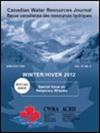Elevation-dependent warming of streams in mountainous regions: implications for temperature modeling and headwater climate refugia
IF 1.7
4区 环境科学与生态学
Q3 WATER RESOURCES
引用次数: 3
Abstract
Abstract Climate change is warming stream temperatures with significant implications for species that require cold temperatures to persist. These species often rely on headwater habitats in mountainous regions where elevation gradients in hydroclimatic conditions may induce differential patterns of long-term warming that affect the resistance of refugia. Forecasts from mechanistic and statistical stream temperature models diverge regarding whether this elevation dependence will cause above- or below-average warming in headwaters during warm summer periods, so we examined monitoring records for stream temperature (n = 271), air temperature (n = 690), and stream discharge (n = 131) across broad elevation gradients in a mountainous region of western North America to better understand potential future trends. Over a 40-year period characterized by rapid climate change from 1976–2015, air temperature stations exhibited below-average warming rates at high elevations while stream discharge declined at above average rates. Between climatically extreme years that involved summer air temperature increases >5 °C and discharge declines >70%, temperatures in high-elevation streams exhibited below average increases but otherwise showed negligible elevation dependence during intermediate climate years. In a subsequent example, it was demonstrated that elevation dependent stream warming has a minor effect on the amount of thermal habitat loss relative to the average water temperature increase within a mountain river network. We conclude that predictions of above average warming effects on headwater organisms for this region may be overly pessimistic and discuss reasons why different types of temperature models make divergent forecasts. Several research areas warrant greater attention, including descriptions of elevation-dependent patterns in other regions for comparative purposes, examination of long-term stream temperature records to understand how sensitivity to climate forcing may be evolving, use of new data sources to better represent key processes in temperature models across broad areas, and development of hybrid models that integrate the best attributes of mechanistic and statistical approaches.山区溪流的海拔依赖性变暖:对温度模型和水源气候避难所的影响
摘要气候变化正在使溪流温度变暖,对需要持续低温的物种具有重大影响。这些物种通常依赖山区的水源栖息地,在那里,水文气候条件下的海拔梯度可能会导致长期变暖的不同模式,从而影响避难所的抵抗力。机械和统计河流温度模型的预测在这种海拔依赖性是否会在温暖的夏季导致源头高于或低于平均水平的变暖方面存在分歧,因此我们检查了河流温度(n = 271),空气温度(n = 690)和流排放(n = 131),以更好地了解未来的潜在趋势。在1976年至2015年的40年时间里,气候变化迅速,高海拔地区的气温站表现出低于平均水平的升温速度,而流量则以高于平均水平的速度下降。在涉及夏季气温升高>5的气候极端年份之间 °C,流量下降>70%,高海拔溪流的温度增幅低于平均水平,但在中等气候年份,其海拔依赖性可忽略不计。在随后的一个例子中,研究表明,相对于山区河网内的平均水温升高,海拔依赖性的河流变暖对热栖息地的损失量影响较小。我们得出的结论是,对该地区水源生物高于平均水平的变暖影响的预测可能过于悲观,并讨论了不同类型的温度模型做出不同预测的原因。几个研究领域值得更多关注,包括出于比较目的对其他地区海拔依赖模式的描述,检查长期河流温度记录以了解对气候强迫的敏感性可能如何演变,使用新的数据源更好地代表广阔地区温度模型中的关键过程,以及开发将机械方法和统计方法的最佳属性相结合的混合模型。
本文章由计算机程序翻译,如有差异,请以英文原文为准。
求助全文
约1分钟内获得全文
求助全文
来源期刊

Canadian Water Resources Journal
WATER RESOURCES-
CiteScore
2.90
自引率
5.90%
发文量
17
审稿时长
>12 weeks
期刊介绍:
The Canadian Water Resources Journal accepts manuscripts in English or French and publishes abstracts in both official languages. Preference is given to manuscripts focusing on science and policy aspects of Canadian water management. Specifically, manuscripts should stimulate public awareness and understanding of Canada''s water resources, encourage recognition of the high priority of water as a resource, and provide new or increased knowledge on some aspect of Canada''s water.
The Canadian Water Resources Journal was first published in the fall of 1976 and it has grown in stature to be recognized as a quality and important publication in the water resources field.
 求助内容:
求助内容: 应助结果提醒方式:
应助结果提醒方式:


